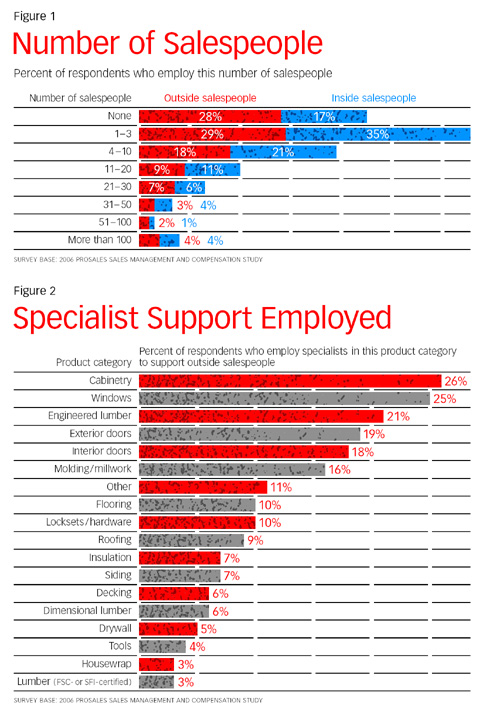But other interviewees tell a very different story about how much rope they give their sellers. Ponder says Wheeler’s allows its 65 field salespeople to negotiate prices “within a certain box,” and gives its sales managers the option to reject that price if they feel it’s too low. “It’s a constant battle not to lower your prices,” he admits. Martin says he and his sales manager set all of Raymond’s pricing and negotiate every deal with builders that are doing more than 50 houses a year. (Sixty percent of this dealer’s builder business comes from national builders.) “We take that [responsibility] out of the salesperson’s hands,” he says.
How sellers are compensated certainly influences how aggressively they negotiate price with their customers. What might be the survey’s most surprising finding shows that the greatest number of respondents—27 percent—pay sellers straight salaries (see Figure 3, left). Franklin Building Supply falls into this group, and Wallace explains that the philosophy behind this compensation structure is that “we’re not successful if our clients aren’t successful. It’s the job of the seller to make the customer successful, and we are all connected.” He notes that his sales team picked up the slack when one of its members was called up to serve in Iraq for 18 months.
Another 23 percent of the survey’s respondents, though, continue to pay their sellers commissions based on a sale’s gross margin. That payout can be considerable: Ridout says his sellers are raking in, on average, 10 percent of what they sell. “Our guys are amply motivated by the commissions we pay out,” he says. Additionally, this year Raymond Building Supply will have at least six outside salespeople who make more than $300,000, says Martin. Several of Wheeler’s sellers will earn that much, too, and at least two will earn nearly $400,000, says Ponder, although he concedes that his company is in a market where it must compete for salespeople with attractive compensation packages.
TW Perry takes the somewhat unique approach of paying its sellers a base salary plus commissions based on the overall margins of an account’s purchases (as opposed to the margins on individual products). Kelly says his company does this to get its sellers to focus on “complete job selling. We want to help our customers through the entire project,” from the framing package to the hardware.
Limited Turnover Parr Lumber’s compensation formula factors in its sellers’ loyalty to and tenure with the company, says Bond. He wouldn’t provide more detail, except to note that this program is a throwback to a period in the 1990s when Parr’s sales team was getting “picked off” by its competitors.
Most dealers seem to be doing a pretty good job holding on to their sales talent, based on the tenure of their selling teams. All but 17 percent of the survey’s respondents say that their sellers, on average, have been with their companies at least three years, and 23 percent say the average tenure of their salespeople is more than 10 years.
The survey also indicates that salespeople are most likely to stick around when they can see growth potential for themselves, and most likely to leave either because of a lifestyle change or because they are having difficulty generating enough business.
Most of the dealers interviewed claim their sales turnover is practically nil, and that they rarely lose a salesperson because of compensation. “Good sellers don’t leave because of pay,” insists Ponder. “They change jobs because they’ve been overlooked or they were promised something they didn’t receive or their feelings were hurt in some way.” For example, Alpine’s status as an employee-owned company since 1988 gives it a distinct advantage when retaining outside salespeople, whose tenures with the company range from five to 20 years, says Taha. And Haynes says that there hasn’t been a lot of movement among McCray’s sellers, either, about half of whom have been with the company 10 years or more. If they went to another company, he explains, “they couldn’t take all of their business with them, so they ask themselves how long it would take to get back to where they are now.”

